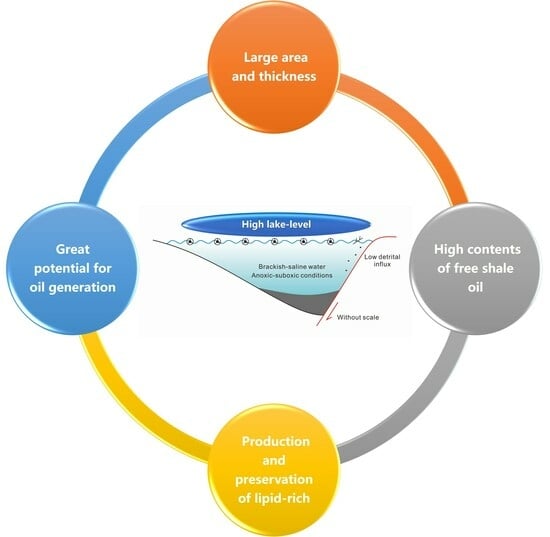Lake-Level-Fluctuation Control on Shale Oil Enrichment of the Salinized Lacustrine Organic-Rich Shale in the Paleogene Biyang Depression, East China
Abstract
1. Introduction
2. Geological Setting
3. Samples and Methods
4. Results
4.1. Organic Petrography and Vitrinite Reflectance
4.2. Bulk Geochemistry
4.3. Pyrolysis Gas Chromatography
4.4. Elemental Compositions
5. Discussion
5.1. Reconstruction of Relative Lake-Level-Fluctuations
5.2. Shale Oil Enrichment
5.3. Control of Lake-Level-Fluctuations on Shale Oil Enrichment and Implications for Regional Shale Oil Exploration
6. Conclusions
Author Contributions
Funding
Data Availability Statement
Conflicts of Interest
References
- Soeder, D.J. The Successful Development of Gas and Oil Resources from Shales in North America. J. Pet. Sci. Eng. 2018, 163, 399–420. [Google Scholar] [CrossRef]
- Lopatin, N.V.; Zubairaev, S.; Kos, I.; Emets, T.P.; Romanov, E.; Mal’chikhina, O.V. Unconventional oil accumulations in the Upper Jurassic Bazhenov Black Shale Formation, West Siberian Basin: A self-sourced reservoir system. J. Pet. Geol. 2003, 26, 225–244. [Google Scholar] [CrossRef]
- Argentina Exports First Shale Oil and Liquefied Natural Gas Cargoes. Oil Energy Trends 2019, 44, 3–6. [CrossRef]
- Wang, M.; Guo, Z.; Jiao, C.; Lu, S.; Li, J.; Xue, H.; Li, J.; Li, J.; Chen, G. Exploration Progress and Geochemical Features of Lacustrine Shale Oils in China. J. Pet. Sci. Eng. 2019, 178, 975–986. [Google Scholar] [CrossRef]
- Hu, S.; Zhao, W.; Hou, L.; Yang, Z.; Zhu, R.; Wu, S.; Bai, B.; Jin, X. Development Potential and Technical Strategy of Continental Shale Oil in China. Petrol. Explor. Dev. 2020, 47, 877–887. [Google Scholar] [CrossRef]
- Liu, B.; Wang, H.; Fu, X.; Bai, Y.; Bai, L.; Jia, M.; He, B. Lithofacies and Depositional Setting of a Highly Prospective Lacustrine Shale Oil Succession from the Upper Cretaceous Qingshankou Formation in the Gulong Sag, Northern Songliao Basin, Northeast China. AAPG Bull. 2019, 103, 405–432. [Google Scholar] [CrossRef]
- Bohacs, K.M.; Carroll, A.R.; John, E.N.; Paul, J.M. Keys to Exploration; Lake-Basin Type, Source Potential, and Hydrocarbon Character within An Integrated Sequence-Stratigraphic/Geochemical Framework. Bull. Houst. Geol. Soc. 2000, 46, 3–34. [Google Scholar]
- Dong, T.; Harris, N.B.; Ayranci, K. Relative sea-level cycles and organic matter accumulation in shales of the Middle and Upper Devonian Horn River Group, northeastern British Columbia, Canada: Insights into sediment flux, redox conditions, and bioproductivity. GSA Bull. 2018, 130, 859–880. [Google Scholar] [CrossRef]
- Peng, J.; Hu, Z.; Feng, D.; Wang, Q. Variations of organic matter content and type within the sequence stratigraphic framework of the lacustrine deep-water Dongyuemiao formation, Sichuan Basin, Western China. Mar. Pet. Geol. 2023, 149, 106104. [Google Scholar] [CrossRef]
- Li, S.; Hu, S.; Xie, X.; Lv, Q.; Huang, X.; Ye, J. Assessment of Shale Oil Potential Using a New Free Hydrocarbon Index. Int. J. Coal Geol. 2016, 156, 74–85. [Google Scholar] [CrossRef]
- Xia, L.; Cao, J.; Hu, S.; Li, S.; Shi, C. Organic Geochemistry, Petrology, and Conventional and Unconventional Hydrocarbon Resource Potential of Paleogene Saline Source Rocks in Eastern China: The Biyang Sag of the Nanxiang Basin. Mar. Pet. Geol. 2019, 101, 343–354. [Google Scholar] [CrossRef]
- Song, Y.; Li, S.; Hu, S. Warm-Humid Paleoclimate Control of Salinized Lacustrine Organic-Rich Shale Deposition in the Oligocene Hetaoyuan Formation of the Biyang Depression, East China. Int. J. Coal Geol. 2019, 202, 69–84. [Google Scholar] [CrossRef]
- Song, Y.; Cao, Q.; Li, S.; Hu, S.; Zhu, K.; Ye, X.; Wan, L. Salinized Lacustrine Organic-Rich Shale Influenced by Marine Incursions: Algal-Microbial Community, Paleoenvironment and Shale Oil Potential in the Paleogene Biyang Depression, East China. Palaeogeogr. Palaeoclimatol. Palaeoecol. 2021, 580, 110621. [Google Scholar] [CrossRef]
- He, T.; Lu, S.; Li, W.; Tan, Z.; Zhang, X. Effect of Salinity on Source Rock Formation and Its Control on the Oil Content in Shales in the Hetaoyuan Formation from the Biyang Depression, Nanxiang Basin, Central China. Energy Fuels 2018, 32, 6698–6707. [Google Scholar] [CrossRef]
- Li, J.; Liu, Z.; Zhang, X.; Feng, G.; Liu, J.; Ma, Y.; Lu, S.; Li, W.; Zhou, N. Effects of Paleoenvironment on Continental Shale Oil Enrichment and Producibility in the Biyang Depression. AAPG Bull. 2022, 106, 2043–2071. [Google Scholar] [CrossRef]
- Xu, K.; Chen, H.; Huang, C.; Ogg, J.G.; Zhu, J.; Lin, S.; Yang, D.; Zhao, P.; Kong, L. Astronomical Time Scale of the Paleogene Lacustrine Paleoclimate Record from the Nanxiang Basin, Central China. Palaeogeogr. Palaeoclimatol. Palaeoecol. 2019, 532, 109253. [Google Scholar] [CrossRef]
- Dong, Y.; Zhu, X.; Xian, B.; Hu, T.; Geng, X.; Liao, J.; Luo, Q. Seismic Geomorphology Study of the Paleogene Hetaoyuan Formation, Central-South Biyang Sag, Nanxiang Basin, China. Mar. Pet. Geol. 2015, 64, 104–124. [Google Scholar] [CrossRef]
- Taylor, H.; Teichmuller, M.; Davis, A.; Diessel, C.F.K.; Littke, R.; Robert, P. Organic Petrology; Borntraeger: Berlin, Germany, 1998; p. 704. [Google Scholar]
- Schudel, G.; Lai, V.; Gordon, K.; Weis, D. Trace Element Characterization of USGS Reference Materials by HR-ICP-MS and Q-ICP-MS. Chem. Geol. 2015, 410, 223–236. [Google Scholar] [CrossRef]
- Teng, J.; Mastalerz, M.; Liu, B. Petrographic and chemical structure characteristics of amorphous organic matter in marine black shales: Insights from Pennsylvanian and Devonian black shales in the Illinois Basin. Int. J. Coal Geol. 2021, 235, 103676. [Google Scholar] [CrossRef]
- Horsfield, B. Practical Criteria for Classifying Kerogens: Some Observations from Pyrolysis-Gas Chromatography. Geochim. Cosmochim. Acta 1989, 53, 891–901. [Google Scholar] [CrossRef]
- Wei, W.; Algeo, T.J. Elemental Proxies for Paleosalinity Analysis of Ancient Shales and Mudrocks. Geochim. Cosmochim. Acta 2020, 287, 341–366. [Google Scholar] [CrossRef]
- Bathurst, R.G. Carbonate Sediments and Their Diagenesis; Developments in Sedimentology; Elsevier: Amsterdam, The Netherlands, 1972; Volume 12. [Google Scholar]
- Tribovillard, N.; Algeo, T.J.; Baudin, F.; Riboulleau, A. Analysis of Marine Environmental Conditions Based on Molybdenum–Uranium Covariation—Applications to Mesozoic Paleoceanography. Chem. Geol. 2012, 324–325, 46–58. [Google Scholar] [CrossRef]
- Algeo, T.J.; Li, C. Redox Classification and Calibration of Redox Thresholds in Sedimentary Systems. Geochim. Cosmochim. Acta 2020, 287, 8–26. [Google Scholar] [CrossRef]
- Tyson, R.V.; Pearson, T.H. Modern and ancient continental shelf anoxia: An overview. In Geological Society, London, Special Publications; Tyson, R.V., Pearson, T.H., Eds.; Geological Society: London, UK, 1991; Volume 58, pp. 1–24. [Google Scholar]
- Ingall, E.D.; Bustin, R.M.; Van Cappellen, P. Influence of water column anoxia on the burial and preservation of carbon and phosphorus in marine shales. GSA Bull. 1993, 57, 303–316. [Google Scholar] [CrossRef]
- Schoepfer, S.D.; Shen, J.; Wei, H.; Tyson, R.V.; Ingall, E.; Algeo, T.J. Total Organic Carbon, Organic Phosphorus, and Biogenic Barium Fluxes as Proxies for Paleomarine Productivity. Earth Sci. Rev. 2015, 149, 23–52. [Google Scholar] [CrossRef]
- Xia, L.; Cao, J.; Hu, S.; Li, S. How Marine Incursion Influences the Quality of Lacustrine Source Rocks: The Paleogene Nanxiang Basin, Eastern China. AAPG Bull. 2019, 103, 1071–1096. [Google Scholar] [CrossRef]
- Hu, S.; Li, S.; Xia, L.; Lv, Q.; Cao, J. On the Internal Oil Migration in Shale Systems and Implications for Shale Oil Accumulation: A Combined Petrological and Geochemical Investigation in the Eocene Nanxiang Basin, China. J. Pet. Sci. Eng. 2020, 184, 106493. [Google Scholar] [CrossRef]
- Espitalie, J.; Marquis, F.; Barsony, I. Geochemical logging. In Analytical Pyrolysis; Voorhess, K.J., Ed.; Butterworths: Boston, MA, USA, 1984; pp. 53–79. [Google Scholar]
- Jarvie, D.M.; Hill, R.J.; Ruble, T.E.; Pollastro, R.M. Unconventional Shale-Gas Systems: The Mississippian Barnett Shale of North-Central Texas as One Model for Thermogenic Shale-Gas Assessment. AAPG Bull. 2007, 91, 475–499. [Google Scholar] [CrossRef]
- Jarvie, D.M. Shale Resource Systems for Oil and Gas: Part 2—Shale-Oil Resource Systems, in J. A. Breyer, ed., Shale reservoirs—Giant resources for the 21st century. AAPG Mem. 2012, 97, 89–119. [Google Scholar]
- Admasu, F.; Back, S.; Toennies, K. Autotracking of faults on 3D seismic data. Geophysics 2006, 71, A49–A53. [Google Scholar] [CrossRef]

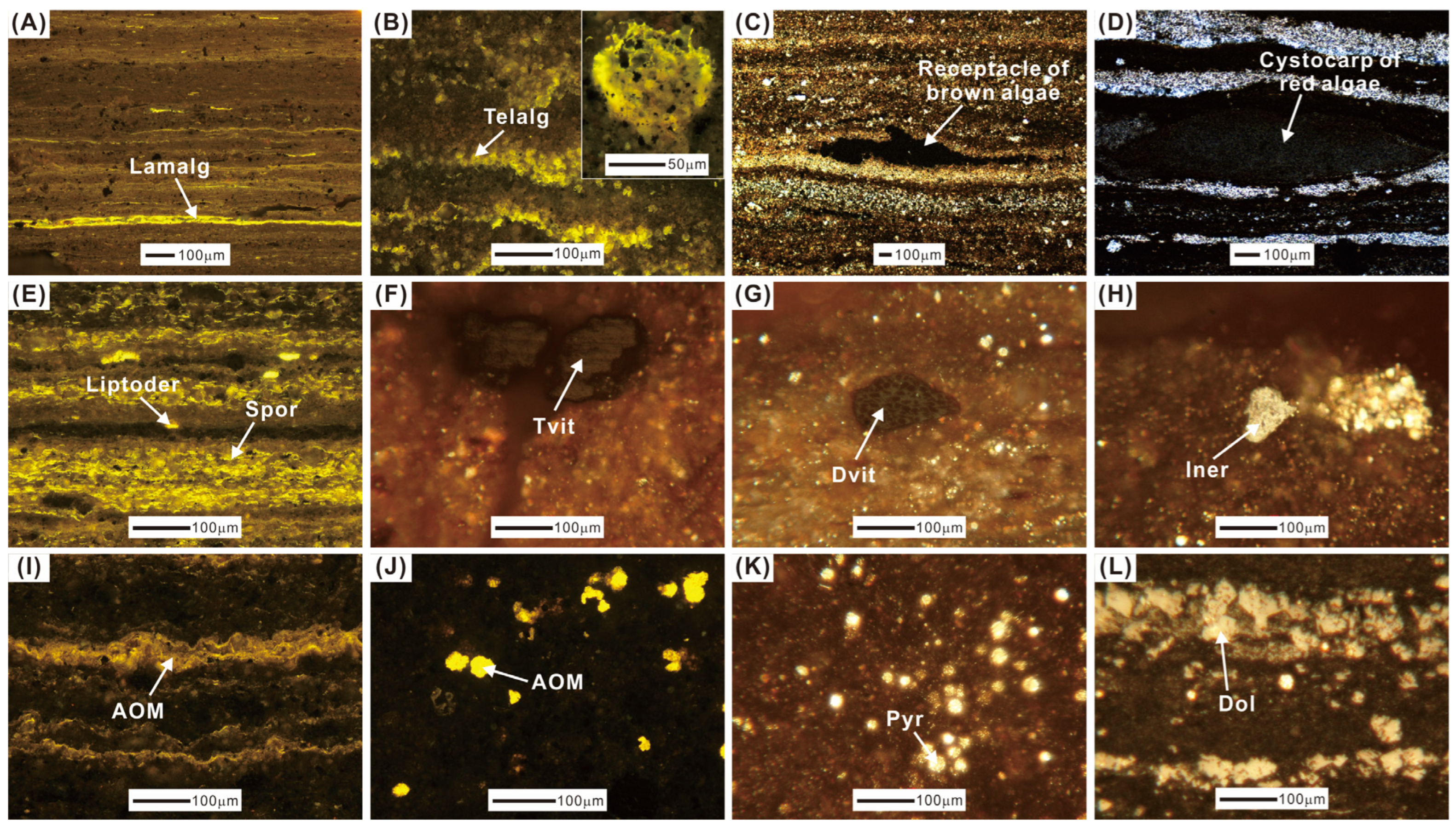
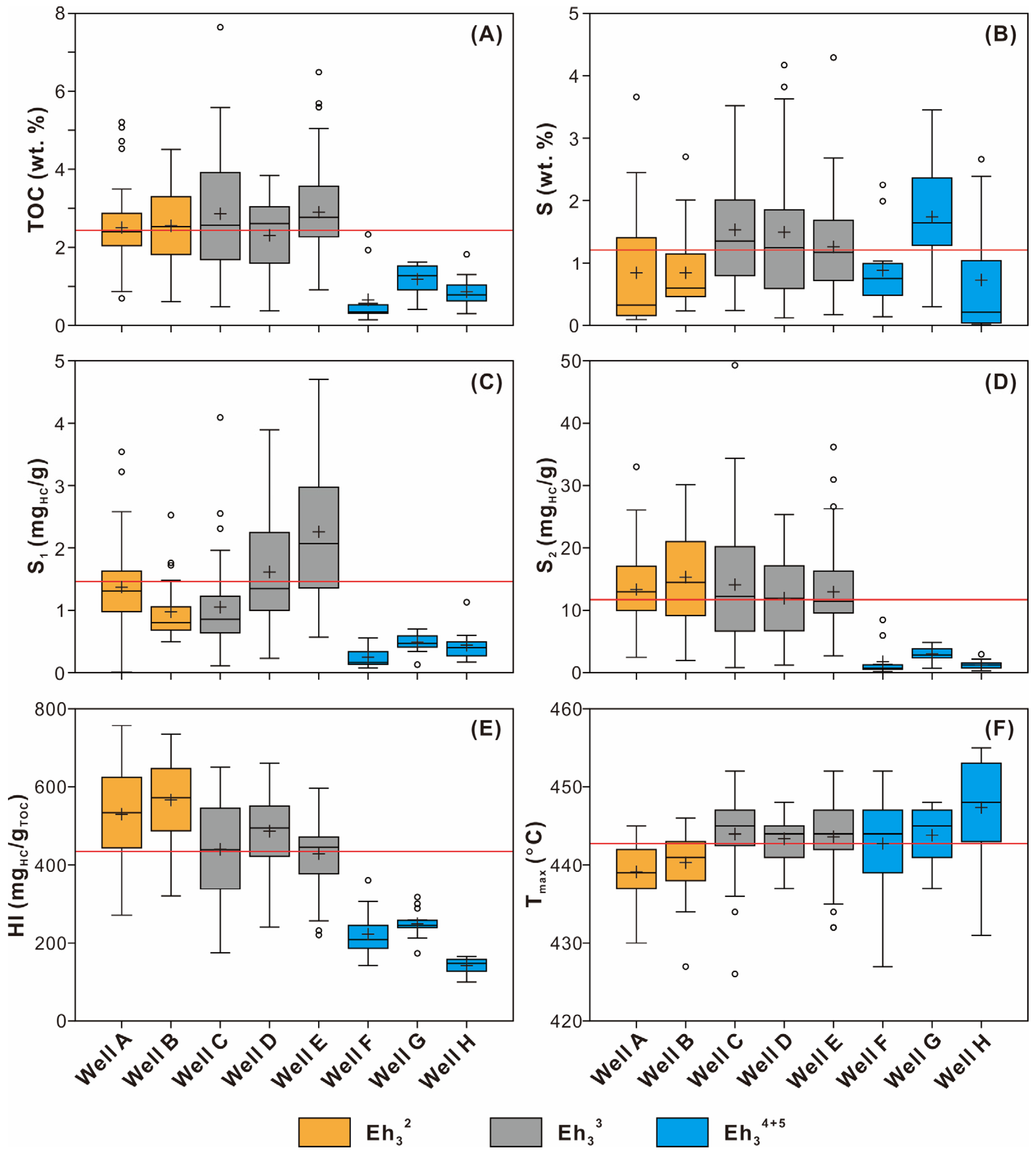

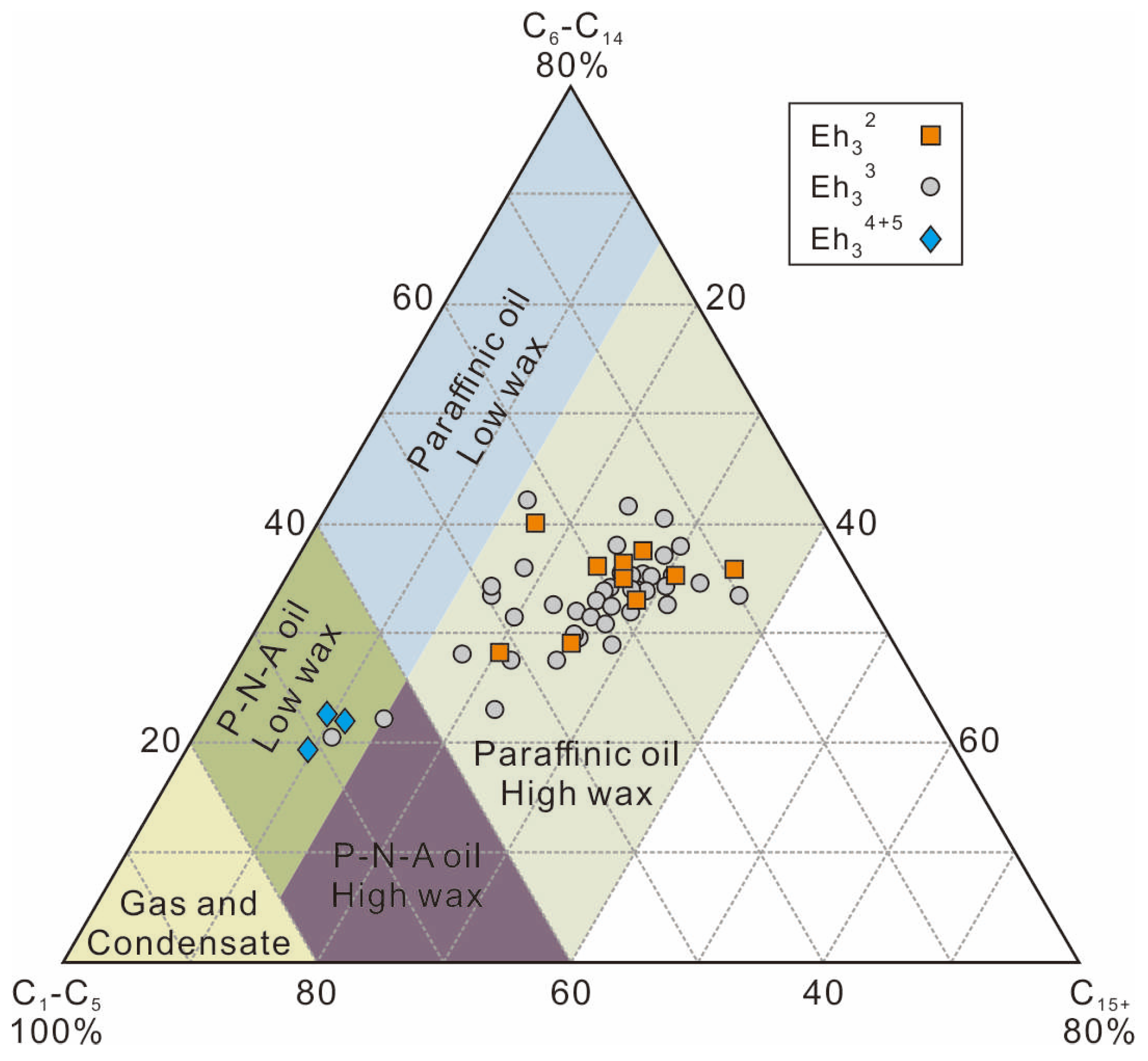

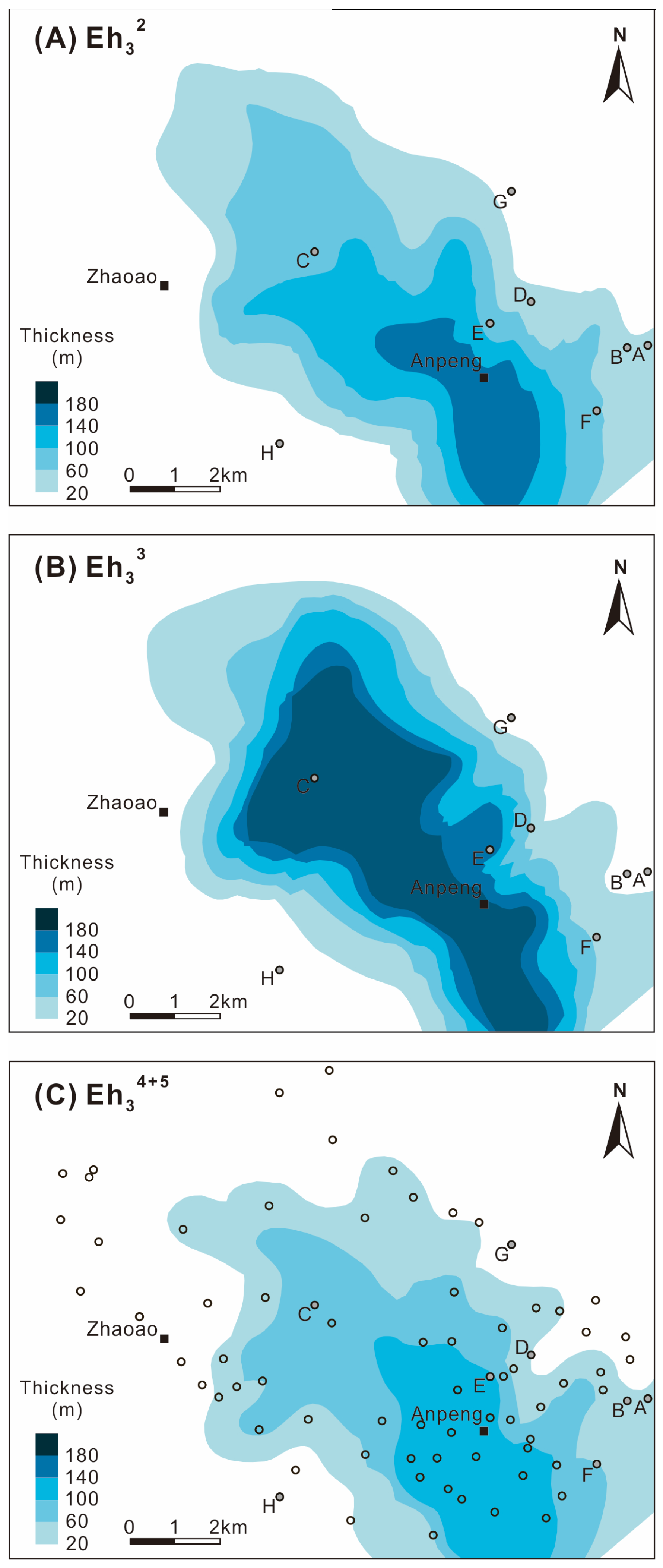
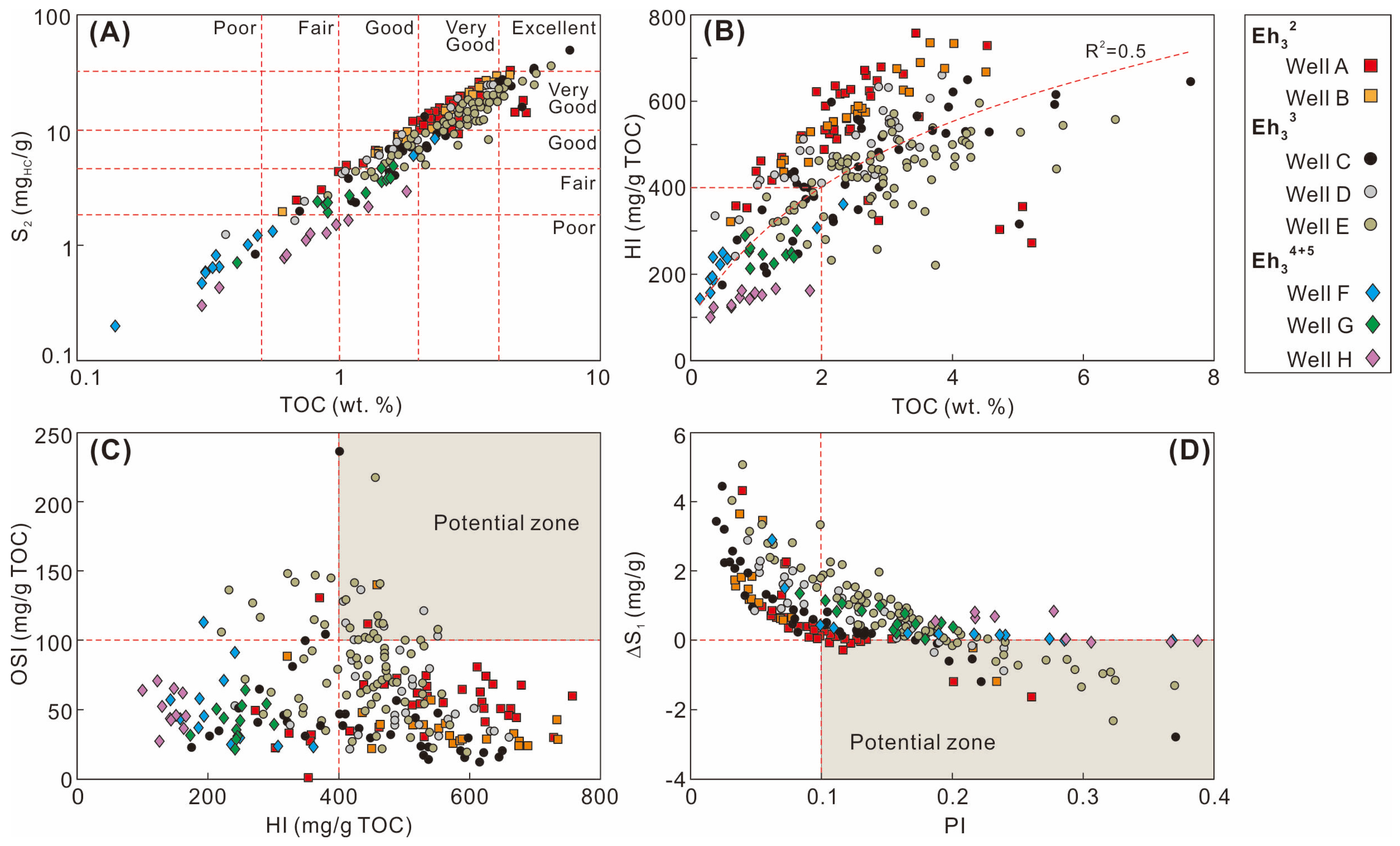
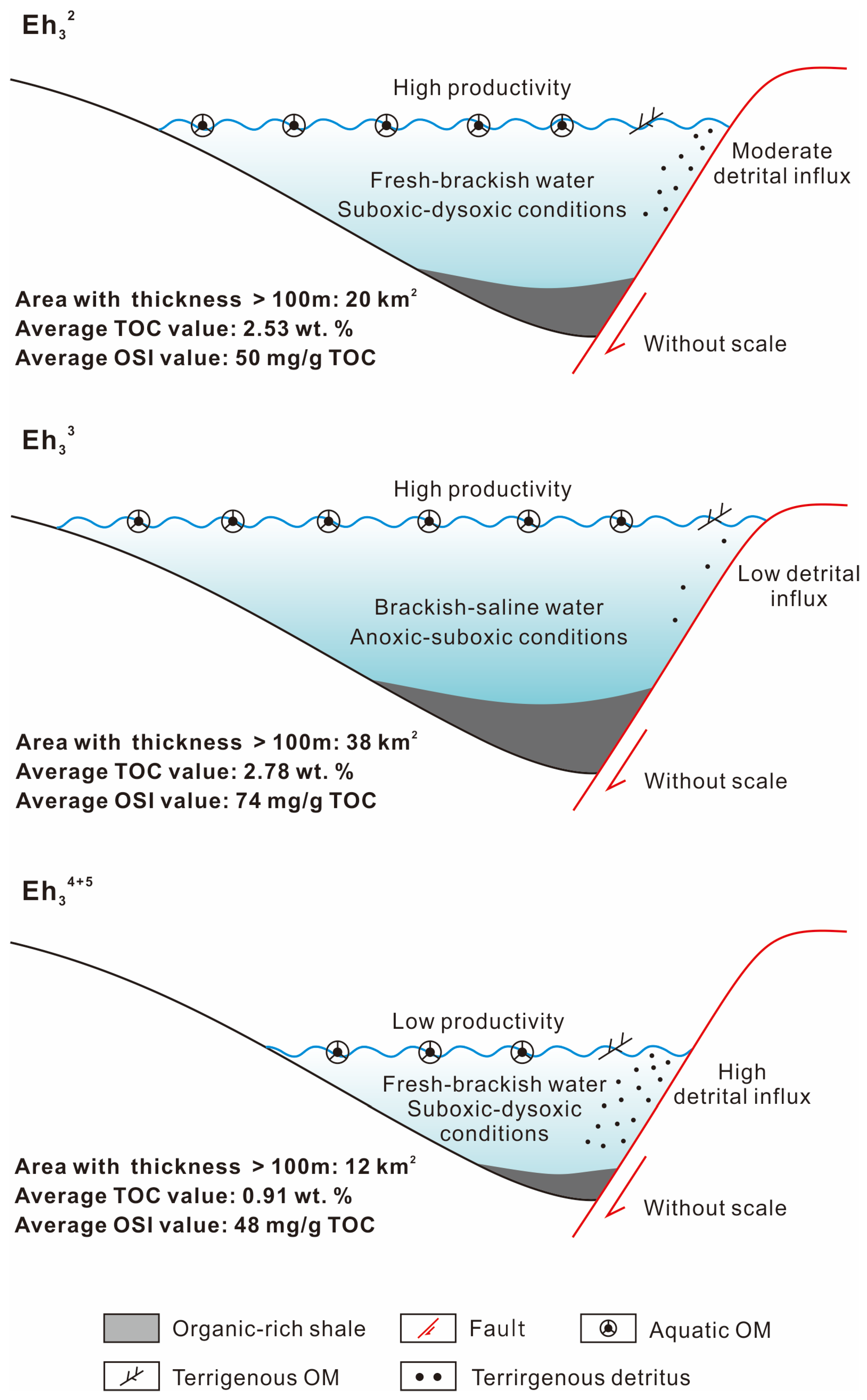

| Well | Number | Unit | Depth (m) | Analytical Number of Samples | ||||
|---|---|---|---|---|---|---|---|---|
| Organic Petrography | Vitrinite Reflectance | Bulk Geochemistry | Pyrolysis Gas Chromatography | Element Geochemistry | ||||
| A | 38 | Unit II | 2392–2409.4 | 10 | 4 | 38 | 10 | 38 |
| B | 24 | 2426.8–2437.5 | 24 | 24 | ||||
| C | 36 | Unit III | 2415.7–2450.2 | 12 | 5 | 36 | 12 | 36 |
| D | 30 | 2720.2–2751.2 | 30 | 30 | ||||
| E | 81 | 2771–2831.9 | 18 | 5 | 81 | 28 | 81 | |
| F | 12 | Unit IV+V | 3122.4–3129.6 | 12 | 12 | |||
| G | 13 | 3182.1–3186.6 | 13 | 13 | ||||
| H | 11 | 3196.2–3214.5 | 7 | 3 | 11 | 3 | 11 | |
Disclaimer/Publisher’s Note: The statements, opinions and data contained in all publications are solely those of the individual author(s) and contributor(s) and not of MDPI and/or the editor(s). MDPI and/or the editor(s) disclaim responsibility for any injury to people or property resulting from any ideas, methods, instructions or products referred to in the content. |
© 2024 by the authors. Licensee MDPI, Basel, Switzerland. This article is an open access article distributed under the terms and conditions of the Creative Commons Attribution (CC BY) license (https://creativecommons.org/licenses/by/4.0/).
Share and Cite
Song, Y.; Wan, L.; Xu, S.; Gao, B.; Li, C.; Li, Z.; Paerzhana, P. Lake-Level-Fluctuation Control on Shale Oil Enrichment of the Salinized Lacustrine Organic-Rich Shale in the Paleogene Biyang Depression, East China. Minerals 2024, 14, 94. https://doi.org/10.3390/min14010094
Song Y, Wan L, Xu S, Gao B, Li C, Li Z, Paerzhana P. Lake-Level-Fluctuation Control on Shale Oil Enrichment of the Salinized Lacustrine Organic-Rich Shale in the Paleogene Biyang Depression, East China. Minerals. 2024; 14(1):94. https://doi.org/10.3390/min14010094
Chicago/Turabian StyleSong, Yu, Li Wan, Shilin Xu, Bo Gao, Chuang Li, Zhonghui Li, and Paerhati Paerzhana. 2024. "Lake-Level-Fluctuation Control on Shale Oil Enrichment of the Salinized Lacustrine Organic-Rich Shale in the Paleogene Biyang Depression, East China" Minerals 14, no. 1: 94. https://doi.org/10.3390/min14010094
APA StyleSong, Y., Wan, L., Xu, S., Gao, B., Li, C., Li, Z., & Paerzhana, P. (2024). Lake-Level-Fluctuation Control on Shale Oil Enrichment of the Salinized Lacustrine Organic-Rich Shale in the Paleogene Biyang Depression, East China. Minerals, 14(1), 94. https://doi.org/10.3390/min14010094





